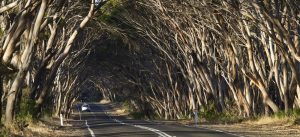National NRM highlights for October 2019 - showcasing NRM highlights from around the nation, including innovative new projects and progress updates. This update represents just a handful among the hundreds of NRM projects going on across Australia, which are made possible through funding from the Australian Government's National Landcare Program.

Image credit: Healthy Land and Water
Each year, Healthy Land and Water carries out comprehensive monitoring of the creeks, rivers, beaches in South East Queensland. These annual audits aim to gain a better understanding of the pressures facing the regions' waterways, their current environmental condition and the social and economic benefits to the community - to better protect them for future generations. Highlights from this year's report include improvements in the condition of Moreton Bay, and the negative impact of the drought in western catchments. For a full picture, click here.

Image credit: Natural resource KI
Until recently, the full extent of Kangaroo Island's Narrow-leaved Mallee Woodland was unknown - which has been a major impediment to effectively managing this critically endangered habitat. As part of a restoration project, Natural Resources KI has accurately mapped this community for the first time, showing that it covers just 1.8% of the island’s land mass (7,878 ha across 832 individual patches). This information will inform restoration activities in the future, including improving the extent and connectivity of this woodland habitat. For more information, head to the Natural Resources KI website.

Image Credit: Rangelands NRM
In late June, the 2019 Species of the Desert Forum (SODF) gathered Indigenous rangers, community and scientists to talk about healthy country and people. Held at the edge of the Great Sandy and Tanami deserts, the forum welcomed 260 rangers, scientists, conservationists, Traditional Owners and local community members from Mulan and Balgo for three days of talks, workshops and training. The workshops included Rangers sharing experiences and knowledge on topics ranging from threatened species management to managing feral animals. For more information, visit the Rangelands NRM news page.

Image credit: Glenelg Hopkins CMA
Glenelg Hopkins CMA, through funding from the Commonwealth and Victoria under the Natural Disaster Relief and Recovery Arrangements (NDRRA), have recently completed the mammoth task of planting 20,000 trees as part of restoration works from the 2016 Glenelg River floods. The NDRRA Flood Recovery Project, which has involved 24 GHCMA staff over the life of the project, as well as contractors, included constructing rock chutes and grass chutes, installation and repair of of trickle pipe units and levee banks, installing coir log networks, repairs to concrete structures, bank armouring and battering and the construction of a pile field on the Glenelg River. For more information, click here.

Image credit: NRM North
In Northern Tasmania, NRM North has been busy delivering work for two threatened species projects; the Giant Freshwater Lobster and the Eastern Barred Bandicoot. Over the last six weeks, around 6000 seedlings have been planted and over 2400m of fencing erected by 11 landholders across the two projects. The program aims to improve the trajectory of species targeted under the Threatened Species Strategy, and other threatened species.

Image credit: Western LLS
At a recent rabbit management workshop, Western Local Land Services in NSW brought together landholders and several groups involved in rabbit management in the Willandra Lakes World Heritage Area for a demonstration day. Attended by 18 people, the demonstration day gave participants an insight into best practice techniques for the management of rabbits, which includes baiting and the ripping of warrens. This included a demonstration of the Rodenator device at Top Hut Station. The Rodenator is used to demolish warrens with minimal disturbance to the top soil which is best practice when working in areas that may have culturally sensitive materials, as is the case in the Willandra Lakes World Heritage Area. Some of the stakeholders involved in the day were the NSW National Parks and Wildlife World Heritage team, the local Aboriginal community, Jensan Farm Services, Western Landcare NSW and local landholders.

Image credit SWCC
In a WA first, drones are being used to monitor western ringtail possums that have been released in the South West after being rehabilitated in a unique ‘finishing school’ environment. South West Catchments Council, together with F.A.W.N.A, the Department of Biodiversity, Conservation and Attractions and the University of Western Australia are working to gain insight into the possum’s behavior once they are released into their native habitat after rehabilitation. Read more at the link.
 Natural Resources SA Murray-Darling Basin (SAMDB) Sustainable Agriculture Team recently commissioned a ground breaking project to assess the soil carbon stocks across the entire SAMDB region covering 5.6 million hectares.
Natural Resources SA Murray-Darling Basin (SAMDB) Sustainable Agriculture Team recently commissioned a ground breaking project to assess the soil carbon stocks across the entire SAMDB region covering 5.6 million hectares.
The study reviewed 7,395 soil tests which were taken between 1989 and 2017 and showed remarkable results.
This investigation, the first of its type in SA, is being used as a benchmark for soil organic carbon (OC) levels over time and to guide field project development and delivery. Long term monitoring sites will soon be established to improve and standardise the monitoring of soil OC levels across the region. The report can be viewed here.
